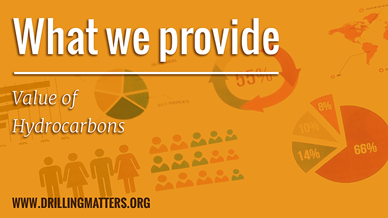
More Than a Fuel
From the food we eat, to the clothes on our backs, to cosmetics and skin care products, soaps and detergents, life-saving medical equipment and pharmaceuticals, building materials, toys and packaging materials, thousands of the products we use and depend on every day are made from hydrocarbons.
One of the most iconic dates back nearly 160 years ago to the birthplace of the US oil industry when a chemist observed how oilmen treated their chapped skin with oil residue from the drill. That residue eventually became Vaseline Petroleum Jelly, today a fixture in medicine cabinets across the globe.
With the abundance of oil and natural gas worldwide -- and the technology to produce them affordably -- there is no limit to the many ways hydrocarbon-based products enhance our lives.
In developed countries, we take for granted all the ways these fossil fuels improve and enhance our lives.
Narration Transcript
Bubble Bath; Tires; Golf Balls; Eyeglasses; Sweaters. Balloons. On the surface, these are things that don’t have anything at all in common.
Actually, they have everything in common: Oil and gas.
In fact, thousands of the products we use and depend on every day are made from hydrocarbons. Not the least of which is the asphalt, or tar, used to pave and upgrade the millions of miles of roads and highways traveled daily by cars, bicycles, trucks and buses and other vehicles worldwide.
A turning point came in 1907, when oil refining byproduct was used as an alternative to expensive imported bitumen to repave the pathway to the US Capitol, covering about 54,000 square yards.
Today, only about 20% of all the petroleum produced goes for the gasoline we put in our cars. About 6 % is used to create the chemicals, plastics and synthetic materials used to manufacture products that make our lives productive, safe and enjoyable.
Petrochemicals and plastic, which are derived from petroleum and natural gas, are commonly used in a variety of products that our lives depend on. These include life-saving medical equipment, such as pacemakers and blood bags, X-ray machines and other imaging devices. Acetylsalicylic acid, or ASA, manufactured from petrochemicals, is the active ingredient in many over-the-counter pain relievers, such as aspirin and ibuprofen. The miracle antibiotic penicillin is also manufactured from petrochemicals.
One of the most well-known of these products dates back nearly 160 years ago to the birthplace of the US oil industry – the Drake Oil Well near Titusville, PA. British chemist Robert Chesebrough, who traveled to Titusville around 1860 to learn what products could be made from petroleum, observed how oilmen in the area treated their skin cuts and burns with residue from the drill.
Chesebrough refined the “stuff,” which he called “petroleum jelly,” and tested it by applying it to minor cuts and burns he inflicted on himself. In 1872, he patented the product – known today as Vaseline Petroleum Jelly, now a part of the global conglomerate Unilever and used by millions worldwide to heal a variety of skin maladies.
So convinced was he of the benefits of his new miracle product, Chesebrough was said to have consumed a spoonful of Vaseline every day, living to the ripe old age of 96!
That was just the beginning. In 1913, a young entrepreneur named Thomas Lyle Williams observed his sister, Mabel, applying a darkening compound, perhaps coal dust, that had been heated over a candle to darken her eyelashes – early-day mascara. Williams decided he could improve this process by adding Vaseline to the mixture, and began selling the product by mail-order catalog. The venture grew to become a billion-dollar business, named for his sister. The company? You guessed it: Maybelline®, now a subsidiary of L’Oréal.
Today, women around the globe enhance their eyelashes with mascara…
And use a variety of other cosmetics and skin care products, including lipstick, nail polish, hair coloring, perfume, cold cream and lotion – all derived from hydrocarbon byproducts, including mineral oil from the distillation of gasoline from petroleum.
Petroleum jelly and mineral oil also are used in many topical antiseptics, including over-the-counter antibiotic creams, ointments and salves for treating burns, cuts, skin infections and conditions such as dandruff and psoriasis.
To get a real perspective on how hydrocarbons impact our lives beyond transportation and related uses, just take out your credit card! That ubiquitous item that is swiped, inserted and tapped billions of times every day is often just referred to as “plastic,” a product derived primarily from materials found in oil and natural gas.
Strong yet lightweight, plastic is increasingly found in a variety of products including interiors and parts of passenger jets and motor vehicles, pipe, lifesaving surgical and medical devices, athletic equipment, consumer packaging and 3-D printers, to name a few. It can be molded, shaped, extruded and cast into many forms, films and foams.
Dolls, toys and games are highly dependent on plastics, one of the most iconic being the Barbie Doll, introduced in 1959…
And the hula hoop, introduced in 1958.
Put simply, plastics are chains of like molecules, or polymers, linked together.
Polymers sold commercially are called resins. In the US, much of the plastic resin manufacturing capacity uses natural gas liquids (mostly from gas processing plants) as a building block, or feedstock. In other parts of the world, primarily Europe and Asia, petroleum-based feedstocks represent the majority of plastic resin production. In 2015, plastic resins consumed 1.8 quadrillion BTUs of hydrocarbon feedstocks.
The shale gas boom that began more than a decade ago, making domestic natural gas and natural gas liquids more abundant and affordable, has significantly increased investment in plastics manufacturing.
Shale gas production in the US has spurred an incremental increase in plastics industry investment, totaling nearly $25 billion for plastic resins, $19.6 billion in plastic processing capacity to convert resins into products and $2.5 billion for plastic compounding and additives. Plastic resin production is expected to grow by more than 50% over the next 10 years.
Plastic manufacturers turn plastic materials, or resins, into a wide variety of end-user products for other industries and ultimately you, the consumer.
In the US, more than $90 billion of plastic materials, or plastic resins typically in pellets, were shipped in 2015, an increase of 17 percent from a decade ago and double the number from 1997. That same year, the plastics products manufacturing industry shipped more than $190 billion in bottles, car parts, vinyl siding, plastic pipes, outdoor furniture and other goods made from plastic.
The 20th century was a significant growth period for the plastics industry. Development of plastics from hydrocarbons began in the 1920s with polyvinyl chloride, known as PVC or vinyl, to replace place natural rubber.
In the 1930s, polyethylene, the basis of modern-day packaging, including food wraps and containers and storage containers, was developed.
In 1933, a Dow Chemical lab worker accidentally discovered with polyvinylidene chloride, known today as Saran™ Wrap;
In 1939, nylon stockings were introduced, replacing silk;
In 1950, the washable synthetic fabric polyester made its debut in America under the name Dacron®, and is still used for carpeting and apparel;
Polypropylene, used in packaging, vehicles and textiles, also gained popularity in the 1950s;
Polystyrene foam was introduced in 1954 and branded as STYROFOAM®, used for insulation, protective packaging and a variety of structures.
A number of other polymer products include polycarbonate, a tough plastic used in bullet-proof glass, medical equipment and consumer goods…
Acrylonitrile butadiene styrene (ABS) used to manufacture appliances, vehicles and LEGOS®…
And polyurethanes, used in cushioning, insulation and clothing.
Oil and natural gas byproducts are also used to make common school and office supplies, used every day -- tape, paints, glue, crayons and pens – all made from hydrocarbons.
Another way hydrocarbons impact our lives involves their use in many cleaning products, including detergents, shampoo and shaving cream -- products we now take for granted and which are essential for maintaining personal hygiene and health, reducing the effects of germs and toxins and extending the life of fabrics.
Detergents, for example, contain surface active agents, or surfactants, made from petrochemicals, derived from petroleum. These surfactants reduce the surface tension of water to enable the cleaning process. Combined with hot water and mechanical action, such as washing machine agitation or hand rubbing, the surfactants are highly effective at loosening and removing dirt and grease.
Hydrocarbons also play a key role in putting food on the table, making agriculture one of the biggest users of petroleum-based products…
Directly, by using diesel, electricity, propane, and natural gas to carry out farm and ranching activities…
And indirectly, through the use of fuel, mostly natural gas, feedstock in the manufacturing of fertilizers and pesticides, which ensure healthy and consistent crop yields.
The manufacture of common nitrogenous, or ammonia-based, fertilizers requires a significant amount of natural gas. The US Energy Information Administration Manufacturing Energy Consumption Survey estimates that the US nitrogenous fertilizer industry consumed more than 200 trillion Btu of natural gas as feedstock in 2010.
From the food we eat, to the clothes on our backs, to cosmetics and skin care products, soaps and detergents, pipe and building materials, toys and packaging materials – and a host of other products -- hydrocarbons deliver much more than fuel for transportation and heating and cooling. With the abundance of oil and natural gas worldwide and the enhanced technical ability to produce them affordably, hydrocarbon-based products enhance our lives in a multitude of ways…
And, give us a lot of reasons to celebrate. After all, you can’t have a birthday party without candles and balloons!







